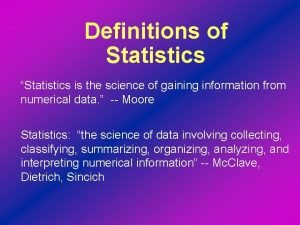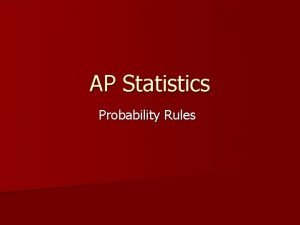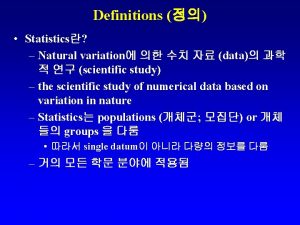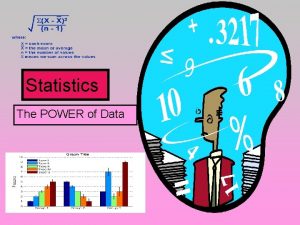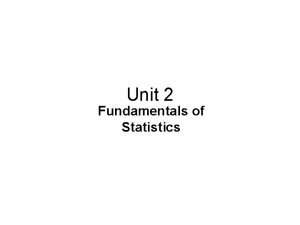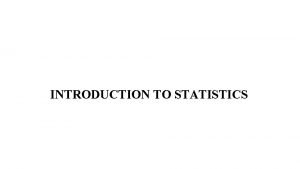Definitions Statistics data scientific study the scientific study



















- Slides: 19

Definitions (정의) • Statistics란? – 자연에서 나타나는 변이에 의한 수치 자료 (data) 의 과학적 연구 (scientific study) – the scientific study of numerical data based on variation in nature – Statistics는 populations (개체군; 모집단) or 개체 들의 groups 을 다룸 • 따라서 single datum이 아니라 다량의 정보를 다룸 – 거의 모든 학문 분야에 적용됨


Definitions (정의) • Biometry, Biological statistics, Biostatistics (생물측정학, 생물통계학) – 생물학적 문제 (biological problem) 해결에 통 계적 방법(statistical methods)의 적용 – 통계학이 molecular biology에서 ecology 까지 광범위하게 생물학에 사용됨 – Cf. Statistics (통계학) and Statistic (통계치) • Sample의 수치 • 평균값 (mean), 표준 편차 (standard deviation), 상 관계수 (correlation coefficient) • Population의 parameter를 추정하는데 사용

Importance of statistical work in biological data The American Naturalist에 발표된 논문 -1890년: 통계가 거의 사용되지 않음 -1990년: 출판된 논문의 96%가 통계처리를 사용함


Basic concepts (기본 개념)

Populations and samples • Statistics는 population (모집단)의 일부분에서 추출한 자료를 바탕으로 모집단의 특성을 추론 (inference)함 – (inference about population based on the data collected from only portion of the population) • population (모집단): 관심, 조사의 대상이 되는 전체 대상체의 집합 – All objects of a particular kind in the universe • sample (표본): population에서 추출된 자료의 집합: – data collected from only portion of the population • 모집단의 특성을 정확히 추정하기 위해서는 모집단 을 대표 할 수 있는 (모집단의 특성이 반영된) 표본의 추출이 중요함 – randomness, independence






Randomness • Random sample이 아님 • Biased sample • 더 성공한 사람들이 더 쉽게 전화로 접촉 될 가능성이 높음 – People who have higher income could be easier to reach by phone

Randomness • Ex. 3. Road survey로 뱀의 population 조사 – Snake populations were estimated by road survey – 봄에 대부분이 수컷으로 조사 됨 (nearly all snakes were male in spring) – 봄에는 소수의 female이 존재한다고 결론 (They concluded that this population has very few females during spring. ) – 올바른 결론인가? (Is this a correct conclusion? ) – 그러나 봄에는 male만 mating을 위해 돌아 다님 • In spring only adult males are actively searching for mates. – 따라서 biased sample (sampling probability is not same!!) – 위의 경우 올바른 sampling을 위하여 조사 생물들의 natural history를 알아야 한다.



Independence • Ex 5. 조류학자가 goldfinches 들이 해바라기 씨와 엉겅 퀴 씨 중 어느 것을 더 좋아하는지를 조사 – If goldfinches prefer sunflower seeds or thistle seeds? – 한 마리의 goldfinch가 해바라기 씨를 50번, 엉겅퀴 씨를 10번 먹음 – – • One goldfinch visited the sunflower seeds 50 times and the thistle seeds 10 times Goldfinch들이 해바라기 씨를 더 좋아한다고 결론 내릴 수 있 나? (Can we conclude that goldfinches prefer sunflower seeds? ) Sample size: 60 or not? Sample size는 1이다. 한 마리의 새만 관찰되었으므로, 모든 관찰이 관련되어 있다 (dependent) 그 한 마리 새는 해바라기 씨를 더 좋아한다는 결론 만 내릴 수 있다


Exercises • 1. Table A. 10의 random number를 이용하 여 bluegill sunfish length (Table B. 1)의 10, 20, 30 simple random samples를 측정하라. – 1. take starting point – 2. record three digits – 3. skip any 3 digit numbers that are larger than 888 – 다음 시간까지 제출할 것
 Definitions of statistics
Definitions of statistics Ap statistics definitions
Ap statistics definitions Introduction to statistics what is statistics
Introduction to statistics what is statistics Hình ảnh bộ gõ cơ thể búng tay
Hình ảnh bộ gõ cơ thể búng tay Lp html
Lp html Bổ thể
Bổ thể Tỉ lệ cơ thể trẻ em
Tỉ lệ cơ thể trẻ em Gấu đi như thế nào
Gấu đi như thế nào Tư thế worm breton là gì
Tư thế worm breton là gì Chúa yêu trần thế
Chúa yêu trần thế Các môn thể thao bắt đầu bằng tiếng nhảy
Các môn thể thao bắt đầu bằng tiếng nhảy Thế nào là hệ số cao nhất
Thế nào là hệ số cao nhất Các châu lục và đại dương trên thế giới
Các châu lục và đại dương trên thế giới Công thức tính thế năng
Công thức tính thế năng Trời xanh đây là của chúng ta thể thơ
Trời xanh đây là của chúng ta thể thơ Mật thư tọa độ 5x5
Mật thư tọa độ 5x5 Phép trừ bù
Phép trừ bù Phản ứng thế ankan
Phản ứng thế ankan Các châu lục và đại dương trên thế giới
Các châu lục và đại dương trên thế giới Thể thơ truyền thống
Thể thơ truyền thống
